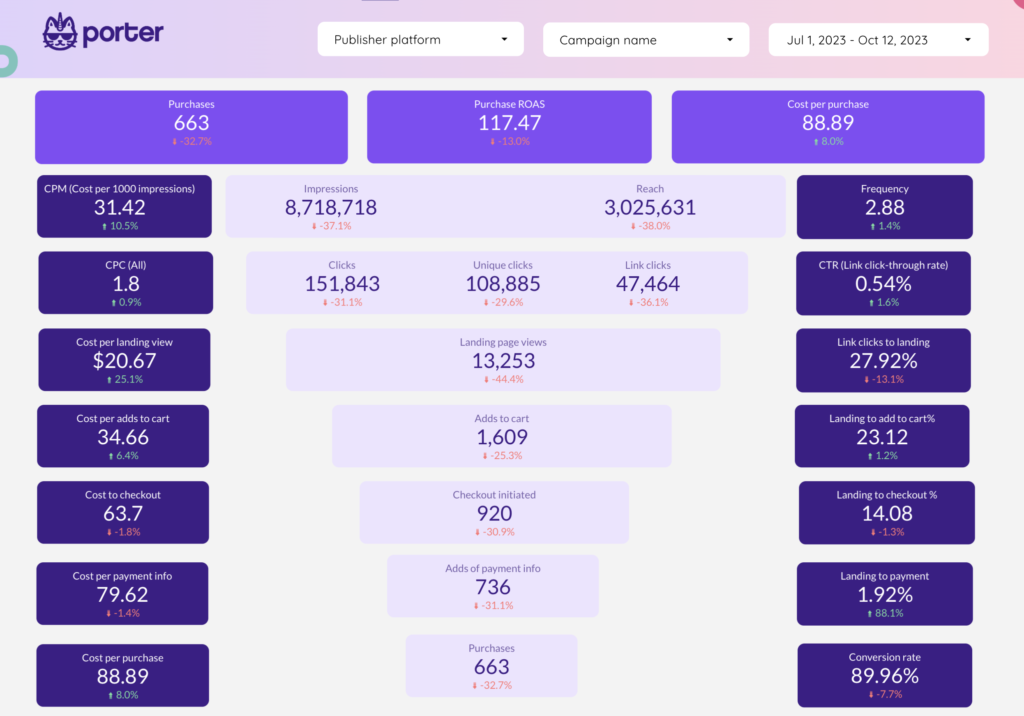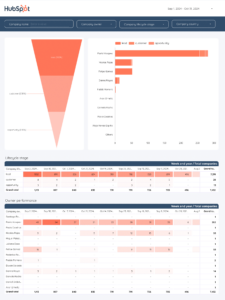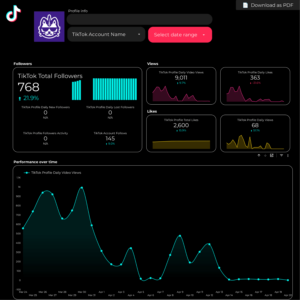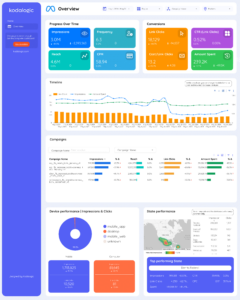To connect HubSpot to Google Looker Studio (formerly Data Studio), go to Create report (or to the Looker Studio community connectors gallery), choose the HubSpot integration by Porter Metrics, connect your Google account, connect your HubSpot accounts, choose your accounts, see the list of fields available, and generate a default report template to monitor your campaigns performance and automate your marketing reports.
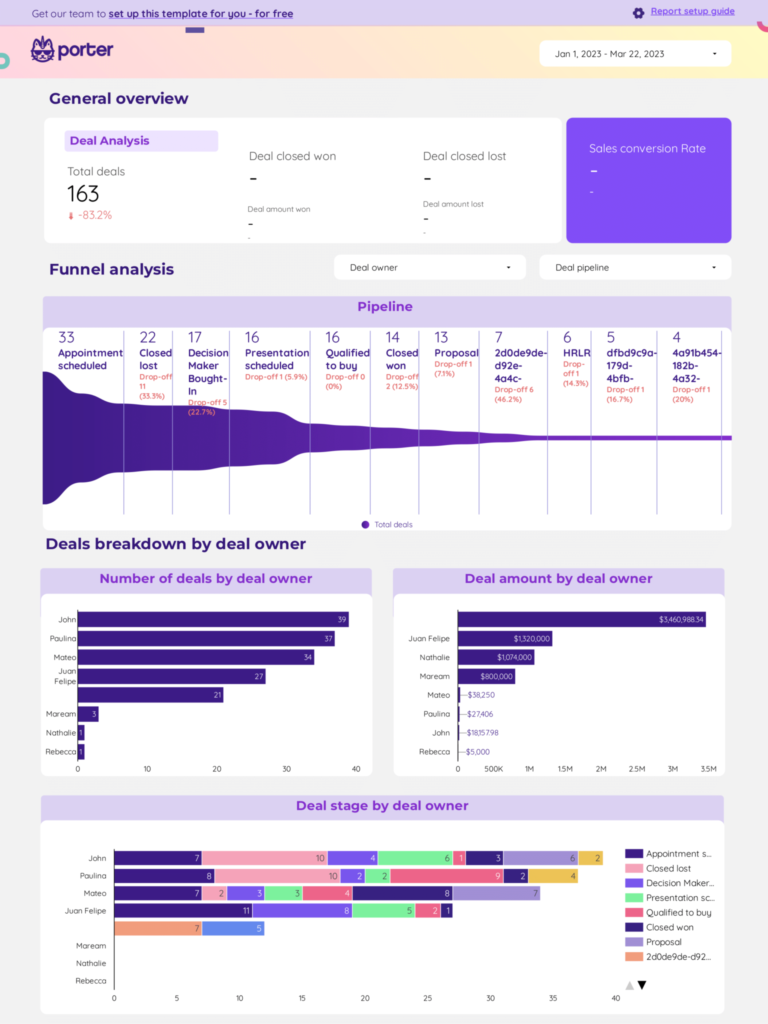
By the end of the tutorial, you’ll know:
- 3 free and paid ways to connect HubSpot to Looker Studio
- Customize your HubSpot reports
- Available HubSpot metrics and dimensions
- Custom HubSpot metrics and dimensions
- Free HubSpot Report templates for Google Looker Studio
Watch our step-by-step YouTube video tutorial:
Free and paid ways to connect HubSpot to Looker Studio
You can connect HubSpot to Looker Studio through a connector (suggested for this tutorial), or importing data first to a Google Sheet automatically or manually.
As an additional resource, learn to connect any data to Looker Studio, or, if you present any problems during the setup, go to our troubleshooting guide.
HubSpot connector for Looker Studio
The advantage of using a direct connector is that you can create charts by freely combining metrics and dimensions, without managing queries or Sheets in between, making it faster and easier to build reports.
In a nutshell, follow these steps when using a HubSpot connector for Looker Studio.
Go to the Porter Metrics onboarding or the Google Looker Studio connectors gallery and choose the HubSpot connector (by Porter).
Connect the same Google account you’re using on Google Looker Studio.
Click on Authorize to connect Porter and Facebook.
Connect the HubSpot account with access to your ad accounts. It doesn’t need to be the same one as the one from Google.
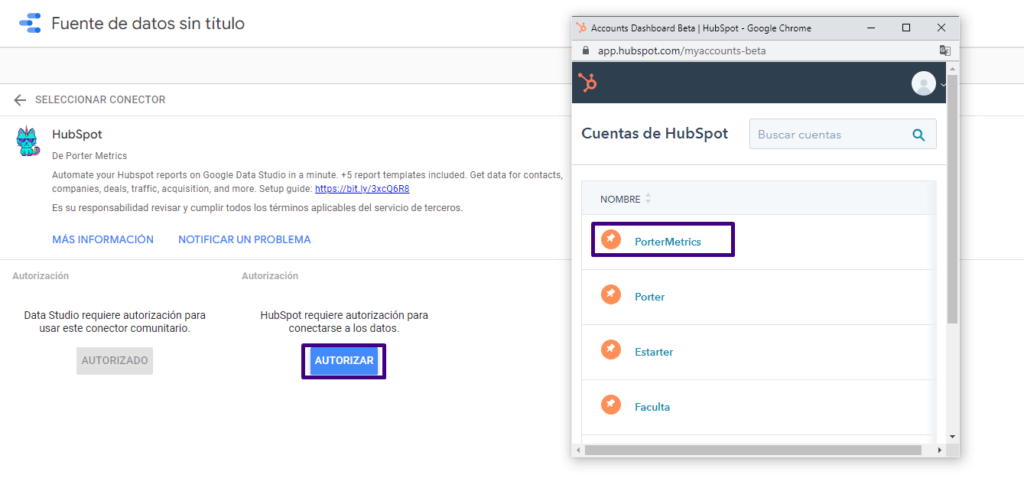
Optionally, connect other HubSpot accounts to connect HubSpot accounts your profile doesn’t have permissions for.
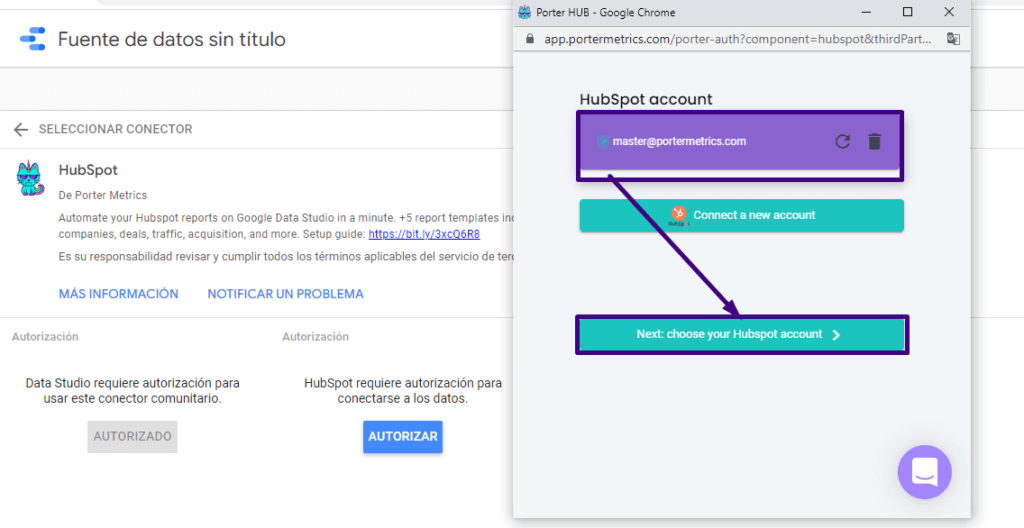
Close the authentication popup and go back to Looker Studio.
Choose one or more HubSpot accounts to use in your reports, and click on Connect.
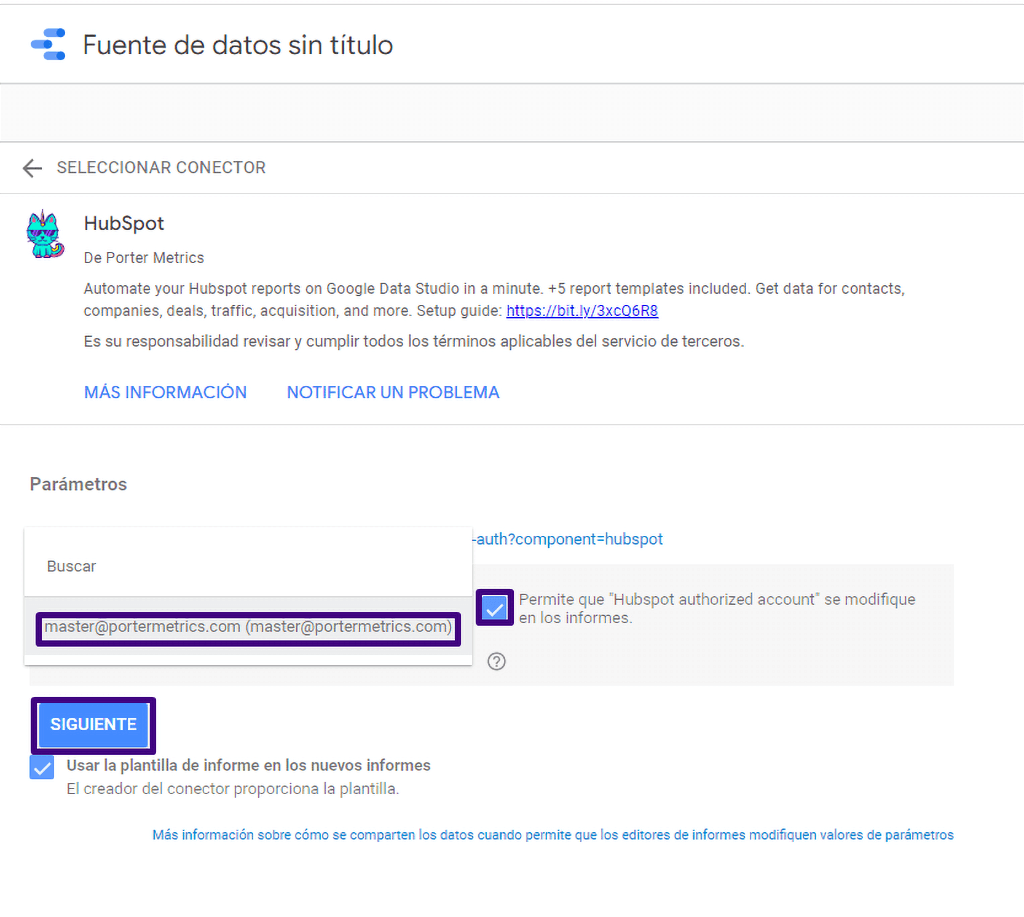
See the fields and go to Create report.
Download our free HubSpot report template for Looker Studio, and start a 14-day free trial:
Importing HubSpot data on Google Sheets
The advantage of using Google Sheets as integration is instant load time when querying small amounts of data, and guaranteed stability, as you’re using Google’s native integrations.
With Sheets, also, you can edit your data. For instance, you could set goals, agency markups or commissions.
As a downside, connecting to Google Sheets first hinders the use of templates and removes data granularity (i.e. freely combining metrics and dimensions when creating charts).
Use the Porter Metrics Google Sheets add-on to automatically import your HubSpot data on a Google Sheet to later connect that Google Sheet to a Looker Studio report.
Uploading a CSV file
As a free option, manually download your HubSpot data as a CSV file and import it on a Google Sheet, but:
- Data won’t refresh and update automatically
- Up to100 uploads
- Max 100MB per CSV
- All CSV files structure must be identical
Customize your HubSpot reports
To continue with the report setup, you can add a new page on the report template just downloaded, or create a new report from scratch, and go to the Edit view.
If you opt to create a new report, here’s how to connect again your data on Looker Studio.
Adding charts
Add scorecards, time series, tables, pie charts, and more chart types to visualize your data.
Scorecards
Scorecards are the most simple way to display your data, by only showing a metric.
Go to Insert, choose a scorecard, and paste it in the canvas.
We’ll use Total contacts as the metric that corresponds to the number of contacts on your CRM on HubSpot.
Create 2 more scorecards by repeating the process or copy-pasting the original scorecard.
Optionally, use Total deals and Total companies, or +200 fields, including custom and standard conversions.
Time series
Time series charts are useful to visualize trends over time.
Go to Insert – Time series.
Use date as date dimension. Use Total contacts as the metric.
Optionally, use other date dimensions like month, week, day of week.
Tables
Tables are the most flexible and complete way to visualize data, letting you add as many metrics and dimensions as you want.
Go to Insert – Table.
Use Deal name and Deal Original source as dimension; Use Deal amount and Deal days to close as the metrics.
Bar charts, pie charts, and maps
Both bar charts and pie charts let you visualize your data by breakdowns. Bar charts are better for cardinal and ordinal data; pie charts are better for nominal data.
Go to Insert – Pie chart.
- For the bar chart, use Deal pipeline as the dimension.
- For the pie chart, use Deal owner as the dimension.
- For the map, use Contact country as the geo dimension.
As metric use Total deals. You can also explore breakdowns for contacts and companies.
Comparisons
Add goals, reference lines, or conditional formats to compare your data and add context.
Comparison date range
Select the scorecards and set Previous Period as the comparison date range.
Reference lines
Select the time series Go to Style – Add a Reference line, choose Metric as type, and Average, as aggregation.
Conditional formatting
Select the time series Go to Style – Conditional formatting, choose Color scale and any metric.
Adding controls
Use dropdowns, search bars, data range controls, or parameters to make your reports interactive by applying filters. Learn more about controls.
Date range controls
Go to Add a control – Dropdown. Choose Date range control to visualize your marketing data daily, weekly, monthly, etc.
Dropdowns
Go to Add a control – Dropdown. Choose Deal pipeline as the dimension.
Design
To influence your team or clients, design and white-label your marketing dashboards. Also, follow our recommendations on designing marketing reports.
Shapes
Use rectangles or circles to draw sections or headers. Right-click the rectangle – Order – Send to back.
Text
Use text to add headers, chart titles, or complementary analysis or comments to your charts.
Go to Text on the Looker Studio menu and paste it in the header of the report. Customize the font family and size.
Colors
Customize the colors of every single chart.
Select the scorecard and go to Style. Change the value size, colors, backgrounds, and borders.
Optionally, select and copy a chart, and copy-paste its style in another chart with right-click – paste special – Paste style only.
Logo
Change the current logo or add your own by choosing Image and uploading a PNG file.
Theme and layout
Change your report’s canvas size, navigation menu, background colors, and default charts’ style.
To customize the theme, go to Theme and Layout – Theme. Choose one of the default templates or customize it.
To customize the layout, go to Theme and Layout – Layout.
- View mode: set the header visibility to Initially hidden; set the navigation type to the left; and set the mode to fit to width and remove the margin to make your report mobile-friendly.
- Canvas size: we’d suggest 1024×768 for a slide view, or 900×1200 for a vertical view.
Navigation
You can create multiple pages for your report, divide them by sections, and add icons.
Go to Page – New page. On Page settings, you can do any customization at a page level, without impacting the whole report.
Share
Share your Google Looker Studio reports with an audience through permissions, links, embeds, PDF, or email schedules.
Permissions
Grant editor or viewer permissions to users with Google accounts within or outside your company.
Schedule delivery
To schedule an automatic report delivery, go to Share – Schedule delivery.
Set the subject, recipients, pages, filters, start date, and frequency to send your reports via email.
Download PDF
Download a PDF version of your reports and, optionally, exclude pages.
We encourage you to take our Google Looker Studio tutorial for marketers and learn to present your marketing reports.
Hubspot metrics and KPIs worth tracking
As reference, see the HubSpot fields list and suggestions for choosing HubSpot KPIs.
The HubSpot connector for Google Looker Studio offers all the +600 metrics and dimensions on the HubSpot CRM, including:
Hubspot CRM
Company:
Companies and contacts have different properties. When we talk about company, we refer to the organisation to which a contact belongs. Also, multiple contacts can be associated with one company.
This information is important because it gives you insights into the company’s size, industry, and more. Let’s take a look at Hubspot’s default company properties:
Company information: includes data such as industry, name, postal code, number of employees, number of associated contacts, time zone, phone number, and more.
Social media information: incudes data relate to social media such as Facebook and LinkedIn company page, Facebook fans, Twitter followers, and more.
Web analytics history includes data such as sessions, page views, and sources.
Conversion information: Includes data such as first conversion (and date), number of form submissions, recent conversion (and date).
You can know in detail all these properties by reading the next article: Hubspot’s default company properties.
Contacts:
This metric includes the number of contacts, new contacts, and lost contacts. Hubspot also categorizes your contacts based on where they are in your marketing and sales processes. The lifecycle stage by Hubspot contains the following stages:
- Subscriber
- Lead
- MQL (marketing qualified leads)
- SQL (sales qualified leads)
- Opportunity
- Customer Evangelist
Do you want to know more about the sales cycle? Please check the following content by Hubspot: Lifecycle stages.
Deals:
This metric includes different properties to help you track and manage your deals, such as the number of deals and won and lost deals. You can also create custom deal properties to capture the information most relevant to your business needs.
Take a look and check Hubspot’s default deal properties
Line ítems:
This metric is particularly important for businesses that sell products or services with multiple line items. With this metric, you can track each line item’s quantity, price, and product in a deal.
Product:
If your business sells products, this metric will be very useful to you. You can use it to track inventory, pricing, multiple currencies, and products.
You can learn more about line items and products in the following article: Creating products in the product library
Hubspot marketing analytics
Forms submissions
This metric includes information about the submitted forms and the number of submissions. You will be able to track metrics such as:
- CTAs clicked: Information about the CTAs that have been clicked (number of clicks)
- Conversion rates: This shows the percentage of people who have completed a goal.
Traffic:
Hubspot can also provide you with general information about your traffic including the number of unique visitors, page views, and bounce rate.
Learn how to analyze your traffic with Hubspot.
Pages:
This metric is particularly important for understanding which pages on your website are most popular and how they contribute to your overall traffic.
If you have a blog, this metric will be very useful to track the number of views, social shares, and comments for each blog post.
And if you have landing pages you will be able to track the number of views, conversion rate, and average time on page.
Acquisition sources:
This metric is used to track where your traffic is coming from. The most common acquisition sources are:
- Organic search
- Paid search
- Social media
- Referral traffic
- Email marketing
You can read the following article to understand HubSpot’s traffic sources.
Custom HubSpot metrics and dimensions
Often, you need to calculate your own metrics:
- You have a different way to calculate formulas
- Need to clean and filter data
- Need to combine from other data sources
To analyze HubSpot data and get accurate marketing KPIs, customize metrics on your Looker Studio reports.
Custom metrics with calculated fields
With Google Looker Studio, you can create custom formulas like done on Sheets. With HubSpot data, some popular use cases include calculating your own:
- Average contacts per deals
- Calculate total days of contacts in a list
- Conversion rate from MQLs to SQLs, and conversion rates across your pipeline
Read more about calculated properties on HubSpot.
Custom dimensions with REGEX
Regular Expressions (or REGEX) on Google Looker Studio let you create custom dimensions to tag or group your data in ways not available by default from the data sources.
Some popular use cases of REGEX for HubSpot are cleaning and standardizing your acquisition data to group your acquisition sources.
As you set formulas to create metrics, you can use case statements to create new dimensions.
We can group contacts by personal emails or business emails by including in one category all the addresses that are Gmail, Outlook Yahoo, etc., and in the other category, we can include company domain emails.
You can also create a new dimension called “Stage” that takes the value of the Lifecycle Stage field and converts it to a stage name.
This is just the tip of the iceberg when it comes to what you can do with Data Studio and Hubspot data.
Clean your data with filters
Set filters at chart, page, or report level.
Select the scorecards (or any chart), go to Setup – Add a filter.
Name your filter, set to Include, Deal pipeline that CONTAINS “SQLs”.
With this filter, you’ll visualize your performance only from Sales Qualified Leads.
Blend data for cross-channel reporting
To fully visualize your funnel or calculate general marketing KPIs accurately, you may need to blend data on Looker Studio from ads, social media, CRM, e-commerce, or GA4.
For HubSpot, some use cases of data blending include:
- Cross-channel reporting on Google Looker Studio
- Blending HubSpot and HubSpot data to calculate actual CPL
Free HubSpot report templates for Looker Studio
To download a Google Looker Studio report template, go to the report, click on the ellipsis icon in the top-right-corner, click on Make a copy, connect a new data source that matches the original data source, and Copy report.
Suggested HubSpot report templates for Looker Studio:

